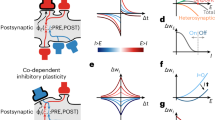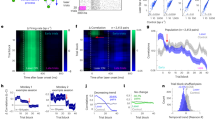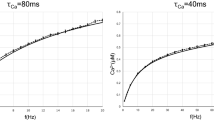Abstract
To act as computational devices, neurons must perform mathematical operations as they transform synaptic and modulatory input into output firing rate1. Experiments and theory indicate that neuronal firing typically represents the sum of synaptic inputs1,2,3, an additive operation, but multiplication of inputs is essential for many computations1. Multiplication by a constant produces a change in the slope, or gain, of the input–output relationship, amplifying or scaling down the sensitivity of the neuron to changes in its input. Such gain modulation occurs in vivo, during contrast invariance of orientation tuning4, attentional scaling5, translation-invariant object recognition6, auditory processing7 and coordinate transformations8,9. Moreover, theoretical studies highlight the necessity of gain modulation in several of these tasks9,10,11. Although potential cellular mechanisms for gain modulation have been identified, they often rely on membrane noise and require restrictive conditions to work3,12,13,14,15,16,17,18. Because nonlinear components are used to scale signals in electronics, we examined whether synaptic nonlinearities are involved in neuronal gain modulation. We used synaptic stimulation and the dynamic-clamp technique to investigate gain modulation in granule cells in acute slices of rat cerebellum. Here we show that when excitation is mediated by synapses with short-term depression (STD), neuronal gain is controlled by an inhibitory conductance in a noise-independent manner, allowing driving and modulatory inputs to be multiplied together. The nonlinearity introduced by STD transforms inhibition-mediated additive shifts in the input–output relationship into multiplicative gain changes. When granule cells were driven with bursts of high-frequency mossy fibre input, as observed in vivo19,20, larger inhibition-mediated gain changes were observed, as expected with greater STD. Simulations of synaptic integration in more complex neocortical neurons suggest that STD-based gain modulation can also operate in neurons with large dendritic trees. Our results establish that neurons receiving depressing excitatory inputs can act as powerful multiplicative devices even when integration of postsynaptic conductances is linear.
This is a preview of subscription content, access via your institution
Access options
Subscribe to this journal
Receive 51 print issues and online access
$199.00 per year
only $3.90 per issue
Buy this article
- Purchase on Springer Link
- Instant access to full article PDF
Prices may be subject to local taxes which are calculated during checkout





Similar content being viewed by others
References
Koch, C. Biophysics of Computation: Information Processing in Single Neurons 552 (Oxford Univ. Press, 1999)
Holt, G. R. & Koch, C. Shunting inhibition does not have a divisive effect on firing rates. Neural Comput. 9, 1001–1013 (1997)
Chance, F. S., Abbott, L. F. & Reyes, A. D. Gain modulation from background synaptic input. Neuron 35, 773–782 (2002)
Anderson, J. S., Lampl, I., Gillespie, D. C. & Ferster, D. The contribution of noise to contrast invariance of orientation tuning in cat visual cortex. Science 290, 1968–1972 (2000)
Treue, S. & Martinez Trujillo, J. C. Feature-based attention influences motion processing gain in macaque visual cortex. Nature 399, 575–579 (1999)
Tovee, M. J., Rolls, E. T. & Azzopardi, P. Translation invariance in the responses to faces of single neurons in the temporal visual cortical areas of the alert macaque. J. Neurophysiol. 72, 1049–1060 (1994)
Ingham, N. J. & McAlpine, D. GABAergic inhibition controls neural gain in inferior colliculus neurons sensitive to interaural time differences. J. Neurosci. 25, 6187–6198 (2005)
Brotchie, P. R., Andersen, R. A., Snyder, L. H. & Goodman, S. J. Head position signals used by parietal neurons to encode locations of visual stimuli. Nature 375, 232–235 (1995)
Yakusheva, T. A. et al. Purkinje cells in posterior cerebellar vermis encode motion in an inertial reference frame. Neuron 54, 973–985 (2007)
Salinas, E. & Abbott, L. F. Transfer of coded information from sensory to motor networks. J. Neurosci. 15, 6461–6474 (1995)
Pouget, A. & Sejnowski, T. J. Spatial transformations in the parietal cortex using basis functions. J. Cogn. Neurosci. 9, 222–237 (1997)
Hansel, D. & van Vreeswijk, C. How noise contributes to contrast invariance of orientation tuning in cat visual cortex. J. Neurosci. 22, 5118–5128 (2002)
Mitchell, S. J. & Silver, R. A. Shunting inhibition modulates neuronal gain during synaptic excitation. Neuron 38, 433–445 (2003)
Gabbiani, F., Krapp, H. G., Koch, C. & Laurent, G. Multiplicative computation in a visual neuron sensitive to looming. Nature 420, 320–324 (2002)
Tiesinga, P. H., Jose, J. V. & Sejnowski, T. J. Comparison of current-driven and conductance-driven neocortical model neurons with Hodgkin–Huxley voltage-gated channels. Phys. Rev. E 62, 8413–8419 (2000)
Murphy, B. K. & Miller, K. D. Multiplicative gain changes are induced by excitation or inhibition alone. J. Neurosci. 23, 10040–10051 (2003)
Prescott, S. A. & De Koninck, Y. Gain control of firing rate by shunting inhibition: roles of synaptic noise and dendritic saturation. Proc. Natl Acad. Sci. USA 100, 2076–2081 (2003)
Fellous, J. M., Rudolph, M., Destexhe, A. & Sejnowski, T. J. Synaptic background noise controls the input/output characteristics of single cells in an in vitro model of in vivo activity. Neuroscience 122, 811–829 (2003)
Rancz, E. A. et al. High-fidelity transmission of sensory information by single cerebellar mossy fibre boutons. Nature 450, 1245–1248 (2007)
van Kan, P. L., Gibson, A. R. & Houk, J. C. Movement-related inputs to intermediate cerebellum of the monkey. J. Neurophysiol. 69, 74–94 (1993)
Saviane, C. & Silver, R. A. Fast vesicle reloading and a large pool sustain high bandwidth transmission at a central synapse. Nature 439, 983–987 (2006)
Semyanov, A., Walker, M. C., Kullmann, D. M. & Silver, R. A. Tonically active GABA A receptors: modulating gain and maintaining the tone. Trends Neurosci. 27, 262–269 (2004)
DiGregorio, D. A., Nusser, Z. & Silver, R. A. Spillover of glutamate onto synaptic AMPA receptors enhances fast transmission at a cerebellar synapse. Neuron 35, 521–533 (2002)
Berends, M., Maex, R. & De Schutter, E. The effect of NMDA receptors on gain modulation. Neural Comput. 17, 2531–2547 (2005)
Cathala, L., Misra, C. & Cull-Candy, S. Developmental profile of the changing properties of NMDA receptors at cerebellar mossy fiber–granule cell synapses. J. Neurosci. 20, 5899–5905 (2000)
London, M. & Hausser, M. Dendritic computation. Annu. Rev. Neurosci. 28, 503–532 (2005)
Kole, M. H. et al. Action potential generation requires a high sodium channel density in the axon initial segment. Nature Neurosci. 11, 178–186 (2008)
Arenz, A., Silver, R. A., Schaefer, A. T. & Margrie, T. W. The contribution of single synapses to sensory representation in vivo . Science 321, 977–980 (2008)
Markram, H. & Tsodyks, M. Redistribution of synaptic efficacy between neocortical pyramidal neurons. Nature 382, 807–810 (1996)
Abbott, L. F., Varela, J. A., Sen, K. & Nelson, S. B. Synaptic depression and cortical gain control. Science 275, 220–224 (1997)
Silver, R. A., Cull-Candy, S. G. & Takahashi, T. Non-NMDA glutamate receptor occupancy and open probability at a rat cerebellar synapse with single and multiple release sites. J. Physiol. (Lond.) 494, 231–250 (1996)
Cathala, L., Brickley, S., Cull-Candy, S. & Farrant, M. Maturation of EPSCs and intrinsic membrane properties enhances precision at a cerebellar synapse. J. Neurosci. 23, 6074–6085 (2003)
Robinson, H. P. & Kawai, N. Injection of digitally synthesized synaptic conductance transients to measure the integrative properties of neurons. J. Neurosci. Methods 49, 157–165 (1993)
Sharp, A. A., O’Neil, M. B., Abbott, L. F. & Marder, E. Dynamic clamp: computer-generated conductances in real neurons. J. Neurophysiol. 69, 992–995 (1993)
D’Angelo, E., De Filippi, G., Rossi, P. & Taglietti, V. Synaptic excitation of individual rat cerebellar granule cells in situ: evidence for the role of NMDA receptors. J. Physiol. (Lond.) 482, 397–413 (1995)
Jorntell, H. & Ekerot, C. F. Properties of somatosensory synaptic integration in cerebellar granule cells in vivo. J. Neurosci. 26, 11786–11797 (2006)
Hines, M. L. & Carnevale, N. T. The NEURON simulation environment. Neural Comput. 9, 1179–1209 (1997)
Varela, J. A. et al. A quantitative description of short-term plasticity at excitatory synapses in layer 2/3 of rat primary visual cortex. J. Neurosci. 17, 7926–7940 (1997)
Gleeson, P., Steuber, V. & Silver, R. A. neuroConstruct: a tool for modeling networks of neurons in 3D space. Neuron 54, 219–235 (2007)
Markram, H., Lubke, J., Frotscher, M., Roth, A. & Sakmann, B. Physiology and anatomy of synaptic connections between thick tufted pyramidal neurones in the developing rat neocortex. J. Physiol. (Lond.) 500, 409–440 (1997)
Gupta, A., Wang, Y. & Markram, H. Organizing principles for a diversity of GABAergic interneurons and synapses in the neocortex. Science 287, 273–278 (2000)
Tsodyks, M. V. & Markram, H. The neural code between neocortical pyramidal neurons depends on neurotransmitter release probability. Proc. Natl Acad. Sci. USA 94, 719–723 (1997); erratum 94, 5495 (1997)
Schwindt, P. C., O’Brien, J. A. & Crill, W. E. Quantitative analysis of firing properties of pyramidal neurons from layer 5 of rat sensorimotor cortex. J. Neurophysiol. 77, 2484–2498 (1997)
Mainen, Z. F., Joerges, J., Huguenard, J. R. & Sejnowski, T. J. A model of spike initiation in neocortical pyramidal neurons. Neuron 15, 1427–1439 (1995)
Acknowledgements
This was supported by the Wellcome Trust, MRC (G0400598) and EU (EUSynapse, LSHM-CT-2005-019055). R.A.S. is in receipt of a Wellcome Senior Research Fellowship. We thank P. Gleeson for help with neuroConstruct, D. Ward and R. Kanichay for their experimental support, D. Digregorio and P. Kirkby for discussions, and A. Arenz, D. Attwell, G. Billings, E. Chaigneau, D. DiGregorio, M. Farrant, F. Minneci and K. Vervaeke for their comments on the manuscript.
Author information
Authors and Affiliations
Corresponding author
Supplementary information
Supplementary Information
This file contains Supplementary Figures S1-S5 and Supplementary Table S1. (PDF 1699 kb)
Rights and permissions
About this article
Cite this article
Rothman, J., Cathala, L., Steuber, V. et al. Synaptic depression enables neuronal gain control. Nature 457, 1015–1018 (2009). https://doi.org/10.1038/nature07604
Received:
Accepted:
Published:
Issue Date:
DOI: https://doi.org/10.1038/nature07604
This article is cited by
-
GSG1L-containing AMPA receptor complexes are defined by their spatiotemporal expression, native interactome and allosteric sites
Nature Communications (2023)
-
Synaptic basis of a sub-second representation of time in a neural circuit model
Nature Communications (2022)
-
Thalamocortical bistable switch as a theoretical model of fibromyalgia pathogenesis inferred from a literature survey
Journal of Computational Neuroscience (2022)
-
NeuroConstruct-based implementation of structured-light stimulated retinal circuitry
BMC Neuroscience (2020)
-
Post-tetanic Potentiation and Depression in Hippocampal Neurons in a Rat Model of Alzheimer’s Disease: Effects of Teucrium Polium Extract
Neurophysiology (2019)
Comments
By submitting a comment you agree to abide by our Terms and Community Guidelines. If you find something abusive or that does not comply with our terms or guidelines please flag it as inappropriate.



